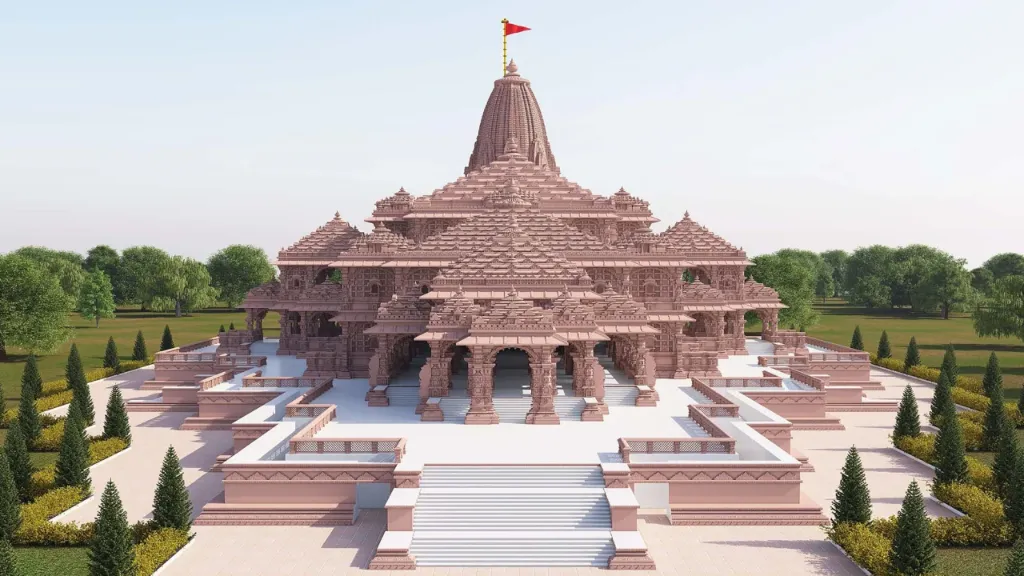Ayodhya Ram Mandir: The Ceremony of the Shri Ram Janmabhoomi Temple is scheduled to take place on January 22, 2024, with dignitaries such as Prime Minister Narendra Modi, UP CM Yogi Adityanath, RSS chief Mohan Bhagwat, UP Governor Anandiben Patel, and the president of the temple trust, Mahant Nritya Gopal Das, in attendance in the grand consecration ceremony of the Shri Ram Janmabhoomi Temple.
| TOTAL AREA | 2.7 ACRES |
| Total built-up area | 57,400 sq feet |
| The total length of the temple | 360 feet |
| Total width of the temple | 235 feet |
| Total height of the temple | 161 feet |
| Total floors | 3 |
| Number of columns on the ground floor | 160 |
| Number of columns on the first floor | 132 |
| Number of columns on the second floor | 72 |
| Number of gates in the temple | 12 |
A notable gathering of over 7,000 individuals, including cricket legends Sachin Tendulkar and Virat Kohli, Bollywood superstar Amitabh Bachchan, and industrialists Mukesh Ambani and Gautam Adani, is expected to witness the event.
🕉️ Ayodhya Ram Mandir: A Grand Symbol of Faith and Heritage
The Ayodhya Ram Mandir stands as a timeless tribute to India’s spiritual heritage. Located at the sacred birthplace of Lord Ram, this temple in Ayodhya, Uttar Pradesh, is a beacon of devotion, unity, and architectural brilliance.
📖 History of the Ram Mandir Ayodhya
The journey of the Ram Janmabhoomi site spans centuries. Devotees have long believed that Lord Ram was born in Ayodhya. After years of legal and cultural discourse, the Supreme Court of India paved the way in 2019 for the construction of the Shri Ram Mandir, marking a new chapter in Indian religious history.
🏗️ Ram Mandir Construction and Architecture
The temple’s construction began in 2020, showcasing a blend of Nagara-style architecture, red sandstone carvings, and eco-conscious practices. The structure includes sanctums, pillared halls, and intricate carvings that narrate Lord Ram’s life. The Ram Mandir inauguration was celebrated with great enthusiasm in January 2024.
📸 Ram Mandir Images and Visuals
Explore stunning Ram Mandir photos capturing the grandeur of the shikhara (spires), mandapas, and artistic murals. These images reflect the spiritual and cultural richness of the Ayodhya Temple.
🔔 Ayodhya Ram Mandir Opening Date and Timings
The temple officially opened its doors on January 22, 2024. Devotees can now visit the shrine from 7:00 AM to 11:30 AM and 2:00 PM to 7:00 PM daily.
🚩 Ram Mandir Location and Travel Guide
Situated in Ramkot, Ayodhya, the temple is well-connected via road, rail, and air. The newly inaugurated Ayodhya Airport makes travel more convenient for pilgrims. If you’re planning to visit, don’t miss nearby sites like Hanuman Garhi, Kanak Bhawan, and the Saryu River Ghats.
📰 Ram Mandir Latest News and Updates
Stay informed with the latest news on ongoing developments, events, and festivities at the Ram Mandir. Live updates are often shared during festivals like Ram Navami and Diwali.
🌟 Significance of Shri Ram Mandir
Beyond being a religious site, the temple is a cultural symbol of resilience and national pride. It honors Lord Ram’s values of righteousness, devotion, and leadership.
Ayodhya Ram Mandir Opening Date:
- The consecration, known as Pran Pratishtha of Lord Ram Lalla, will occur on the upcoming Paush Shukla Kurma Dwadashi, Vikram Samvat 2080, falling on January 22 (Monday) in the Vikram Samvat 2080 calendar. Following this, the temple will open its doors to devotees from January 23.
More Information about Ayodhya Ram Mandir:
- The Ram temple complex is 380 feet long, 250 feet wide, and 161 feet high.
- It has 20-foot-high floors, 392 pillars, 44 gates, and uses no iron.
- The Nagara style features towering spires, intricate carvings, and symbolic representations.
Ayodhya Ram Mandir Construction Information Journey:
- The Ram Mandir design by the Sompura family in 1988 was modified in 2020.
- The Sompuras, renowned architects, have designed over 100 temples, including the Somnath temple.
- The temple spans 71 acres and is divided into six main parts.
- The temple’s parts include the sanctum sanctorum and five pavilions: Gun, Rang, Nritya, Kirtan, and Prarthana Mandap.
Details of Temple Construction:
- Around 1,200 skilled technicians are working on carving and erection at various sites.
- Expert agencies, including NIRM, CB Sompura, L&T, and TCE, supervise stone quality and craftsmanship.
Key Features of Ram Temple Construction:
- The three-storied temple has 20-foot walls without any iron in construction.
- The temple is 380 feet long, 250 feet wide, and 161 feet tall.
- It features 392 pillars, 44 doors, and an east entrance with 32 stairs.
- The temple entrance is adorned with Rajasthani sand pink stone in the Nagar style.
- Temples within the complex honor Maharshi Valmiki, Vashishtha, Vishwamitra, and other revered figures.
- There is a Mandir of Maa Annapurna in the north and Hanuman Ji in the south.
History of the Ayodhya Ram Mandir Temple:
- Ram Temple construction began in 2020 after Prime Minister Modi laid the foundation.
- The 2019 Supreme Court ruling allocated the disputed Ayodhya land to the Hindu side.
- An alternative land was provided to the Muslim community for a potential mosque.
- The legal dispute, starting in 1950, involved conflicting claims over the land’s significance.
- The Supreme Court’s decision resolved the long-standing conflict over the site.
Ram Temple Significance:
- The Ayodhya Ram Mandir is a key pilgrimage site, believed to be Lord Ram’s birthplace. Its construction symbolizes a historic victory for Hindus who advocated for it for decades. The upcoming inauguration marks a major achievement, concluding a long movement. This event is globally significant for Hindus, marking a key religious milestone.
Attendees and Absentees at the Ram Temple Pran Pratishtha Ceremony
- Among the distinguished attendees are Prime Minister Modi, Chief Minister Yogi, RSS chief Mohan Bhagwat, LK Advani, JP Nadda, and Eknath Shinde.
- The guest list extends to prominent figures from the entertainment industry, including Bollywood luminaries Amitabh Bachchan, Akshay Kumar, Kangana Ranaut, cricketers Sachin Tendulkar and Virat Kohli, Yoga Ramdev, and industrialists Mukesh Ambani, Ratan Tata, and Gautam Adani.
Notably, some political figures, such as Congress leaders Mallikarjun Kharge, Sonia Gandhi, and Adhir Ranjan Chowdhury, have opted not to attend. Others, including Sharad Pawar, Mamata Banerjee, Akhilesh Yadav, Sitaram Yechury, and Uddhav Thackeray, will also be absent from the event.
RAM MANDIR PRASAD
- In preparation for the consecration ceremony, a group of esteemed confectioners from Varanasi and Gujarat has arrived in Ayodhya. Their mission involves crafting 45 tonnes of laddus as offerings for devotees and participants. These delectable laddus, prepared with pure desi ghee, will serve as prasad during the historic Pran Pratishtha ceremony. The confectioners express their dedication, having commenced laddu production on January 6 and continuing their efforts until January 22, the day of the ceremony.
Planning Your Journey:
- Timing: The Ram Mandir welcomes devotees from dawn to dusk, though darshan (viewing the idols) timings may vary.
- Dress Code: Respect and modesty are key; cover your head and shoulders.
- Etiquette: Remember to maintain decorum and silence within the temple complex.
Find a Meditation Centre Near Me
Searching for a meditation centre near me can be the first step towards achieving inner peace and mindfulness. A local Brahma Kumaris meditation centre provides a serene environment where you can learn various meditation techniques, guided by experienced instructors. Whether you’re new to meditation or looking to deepen your practice, finding a meditation centre near me offers the convenience of regular sessions without long commutes. These centers often offer a variety of classes, workshops, and retreats tailored to different levels, helping you cultivate a calm mind and a balanced life. Start your journey to well-being today.






[…] After years of historical significance and legal deliberations, the construction of the grand Ayodhya Ram Mandir began in Ayodhya. The temple envisioned in the traditional Nagara style, is set to become a […]
[…] Ayodhya Ram Mandir […]
[…] Ayodhya Ram Mandir, a historic and revered temple, stands as a symbol of deep religious significance and cultural […]